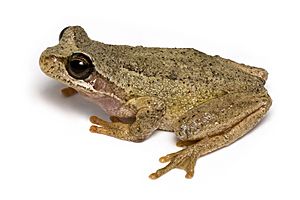List of amphibians of Tasmania facts for kids

Tasmania, a beautiful island state of Australia, is home to many amazing creatures, including a special group called amphibians. All of Tasmania's amphibians are frogs! These fascinating animals are unique because they can live both in water and on land. They start their lives in water as tadpoles and then change into frogs, ready to explore the land.
Contents
Meet Tasmania's Amphibians
Amphibians are cold-blooded animals, meaning their body temperature changes with their surroundings. They have smooth, moist skin that helps them breathe and absorb water. Frogs are a type of amphibian, and Tasmania has a wonderful variety of them. Each frog has its own special calls and habits, making the island's wetlands and forests lively places.
What Makes a Frog an Amphibian?
Frogs go through an amazing transformation called metamorphosis. It's like a superpower!
- They start as eggs, usually laid in water.
- The eggs hatch into tadpoles, which look like tiny fish. Tadpoles live completely in water and breathe with gills.
- As they grow, tadpoles develop legs, and their tails slowly disappear. Their gills are replaced by lungs, allowing them to breathe air.
- Finally, they become adult frogs, ready to hop onto land.
Tasmania's Froggy Friends: A Closer Look
Here are some of the unique frogs you can find hopping around Tasmania:
- 'Moss froglet (Crinia nimbus): This tiny frog is quite rare and lives in wet, mossy areas. It's very good at hiding!
- 'Common eastern froglet (Crinia signifera): You might hear this frog's "crick-crick" call in many places. It's one of the most common frogs in eastern Australia, including Tasmania.
- 'Tasmanian froglet (Crinia tasmaniensis): This frog is special because it's only found in Tasmania! It's adapted to the island's cooler climate.
- 'Smooth froglet (Geocrinia laevis): Known for its smooth skin and gentle call, this frog prefers damp places like swamps and wet forests.
- 'Eastern banjo frog (Limnodynastes dumerilii): Also called the "Pobblebonk" because of its distinctive "bonk" call, like a banjo string being plucked. They are quite large and often hide in burrows.
- 'Striped marsh frog (Limnodynastes peronii): You can spot this frog by the stripes on its back. It has a loud "whack" or "tok" call, especially after rain.
- 'Spotted grass frog (Limnodynastes tasmaniensis): This frog has a beautiful spotted pattern and a rapid "quack-quack" call. It loves grassy areas near water.
- 'Southern brown tree frog (Litoria ewingii): This is a very common and adaptable frog. It can be found in many different habitats, from gardens to forests. It has a soft "weep-weep-weep" call.
- 'Tasmanian tree frog (Litoria burrowsae): Another frog unique to Tasmania! It's a beautiful green frog that lives in trees and shrubs near water.
- 'Southern toadlet (Pseudophryne semimarmorata): Despite its name, it's a frog, not a toad. It's small and has warty skin, often found under logs or rocks.
- 'Growling grass frog (Ranoidea raniformis): This large frog has a call that sounds like a growl or a motor. It's an endangered species, meaning it needs our help to survive.
Why Are Frogs Important?
Frogs play a very important role in nature. They are like tiny superheroes for the environment!
- Pest Control: Frogs eat lots of insects, including mosquitoes and flies. This helps keep insect populations in balance.
- Food Source: They are also food for other animals like birds, snakes, and small mammals. This makes them a vital part of the food chain.
- Environmental Indicators: Because their skin is so sensitive, frogs are often the first animals to be affected by pollution or changes in their habitat. Scientists call them "bio-indicators" because they can tell us if an environment is healthy or not. If frogs are struggling, it's a sign that something might be wrong with the ecosystem.
Protecting Tasmania's Frogs
Sadly, many frog species around the world, including some in Tasmania, are facing challenges. Their homes are disappearing due to human activities like building and farming. Pollution from chemicals can also harm them. A serious disease called chytrid fungus is also a big threat to frogs globally.
We can all help protect these amazing amphibians:
- Protect Habitats: Support efforts to conserve wetlands, forests, and other natural areas where frogs live.
- Keep Water Clean: Avoid using chemicals that can run into waterways and harm frogs.
- Be Careful: If you are exploring natural areas, try not to disturb frog habitats. Never move frogs from one place to another, as this can spread diseases.
- Learn More: The more we learn about frogs, the more we can appreciate and protect them.
By understanding and caring for Tasmania's unique frogs, we can help ensure they continue to thrive for many years to come.

